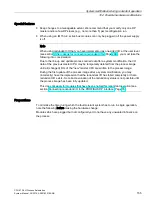
CPU 410-5H Process Automation
System Manual, 09/2014, A5E31622160-AB
151
System modifications during redundant operation
10
10.1
System modifications during operation
In addition to the options described in the chapter Failure and replacement of components
during redundant operation (Page 185) to replace failed components during operation, you
can also make a system modification with the CPU 410-5H without interrupting the running
program.
The procedure and scope depend on the operating mode of the CPU.
●
Modifications to the Profibus I/O can be made to a limited extent in stand-alone operation.
The procedure is described in a separate manual, see Modifying the System during
Operation via CiR (
http://support.automation.siemens.com/WW/view/en/14044916
●
More extensive modifications to the I/O and the CPU parameters are possible in
redundant mode. Detailed information is available in the chapters below.
The procedures described below for making changes during operation are each created in
such a way that they start from the redundant system state (see Chapter The system states
of the fault-tolerant system (Page 109)) and have as their objective a return to redundant
system state.
Note
Keep strictly to the rules described in this section with regard to modifications of the system
in runtime. If you contravene one or more rules, the response of the fault-tolerant system can
result in its availability being restricted or even failure of the entire automation system.
Only perform a system change in runtime when there is no redundancy error, i.e., when the
REDF LED is not lit. The automation system may otherwise fail.
The cause of a redundancy error is listed in the diagnostics buffer.
Safety-related components are not taken into account in this description. For more
information on handling fail-safe systems refer to the
S7 F/FH Systems - Configuring and
Programming manual.
















































